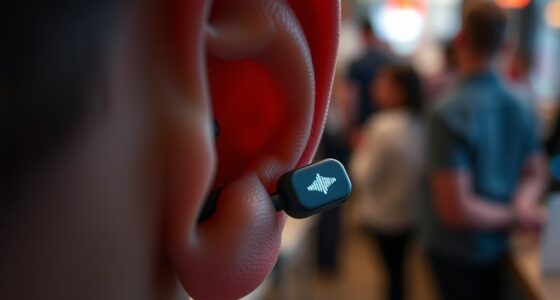Scientific research shows that electromagnetic fields from wireless devices are generally safe when you follow safety guidelines. Non-ionizing radiation from Wi-Fi, cellphones, and other tech doesn’t have enough energy to harm your DNA or cause cancer. Most studies find no consistent link between typical EMF exposure and health risks. Regulatory agencies ensure levels stay within safe limits. If you want to learn about the facts versus fears surrounding EMF, explore the details that clarify these concerns.
Key Takeaways
- Wireless EMFs emit non-ionizing radiation, which lacks enough energy to damage DNA or cause cancer.
- Extensive scientific research shows no consistent link between typical wireless EMF exposure and health risks.
- Regulatory safety guidelines ensure exposure levels remain within proven safe limits, minimizing health concerns.
- Ongoing studies and monitoring support the current understanding that wireless technology is safe when standards are followed.
- Many fears are based on misconceptions or preliminary data, with current evidence favoring the safety of wireless device use.

Have you ever wondered how electromagnetic fields (EMFs) from everyday devices might affect your health? With wireless technology becoming such a common part of daily life, it’s natural to question whether these invisible fields pose real health concerns. Many people worry that exposure to EMFs from cell phones, Wi-Fi routers, and other wireless devices could lead to serious health issues, but it’s essential to distinguish between proven facts and fear-based fiction. Scientific research has extensively studied the potential effects of electromagnetic fields, and while some concerns are valid, much of the alarm surrounding wireless technology is exaggerated.
Wireless technology emits non-ionizing radiation, which means it doesn’t have enough energy to directly damage your DNA or cause cancer like ionizing radiation from X-rays or radioactive materials. Studies over the years have shown no consistent evidence linking typical exposure levels from cell phones or Wi-Fi to increased cancer risk or other serious health problems. Regulatory agencies such as the World Health Organization (WHO) and the Federal Communications Commission (FCC) have established safety guidelines designed to limit exposure well below levels that could cause harm. These safety standards are based on thorough research, and most everyday exposure remains within these safe limits.
Wireless devices emit non-ionizing radiation, with no proven link to health risks at typical exposure levels.
However, some health concerns persist, fueled by fears of long-term effects and the rapid proliferation of wireless technology. Critics argue that the technology is too new for long-term health impacts to be fully understood, and they advocate for precautionary measures. While it’s prudent to stay informed and use devices responsibly—such as keeping phones away from your body when not in use or limiting screen time—there’s little scientific evidence to suggest that routine exposure at typical levels causes health issues. The key is understanding that not all fears are backed by solid science; many are based on misconceptions or misinterpretations of preliminary data.
It’s also worth noting that the advancements in wireless technology have led to improvements in connectivity, safety, and convenience, with no confirmed link to adverse health effects when standards are followed. The ongoing research continues to monitor potential risks, but current evidence supports the view that everyday exposure to EMFs from wireless devices is safe for the general population. Staying informed through reputable sources helps you make better decisions about your health, rather than succumbing to unfounded fears. Ultimately, while it’s wise to be cautious and aware of your environment, the scientific consensus suggests that typical EMF exposure from wireless technology isn’t a significant health concern.
Furthermore, ongoing AI security research helps ensure that emerging wireless and digital technologies remain safe and reliable, providing additional reassurance for consumers.
Frequently Asked Questions
How Do EMF Levels Vary Between Different Electronic Devices?
You’ll notice that different electronic devices have varying device emissions, impacting emf measurement results. For example, smartphones and Wi-Fi routers typically emit higher emf levels than older devices like landline phones. When you measure emf, you’ll find that portable or wireless devices tend to produce more electromagnetic fields, especially close to the source. Understanding these differences helps you make informed choices about your device usage and exposure.
Are Children More Vulnerable to EMF Exposure Than Adults?
You might wonder if children are more vulnerable to EMF exposure. Child sensitivity and developmental vulnerabilities suggest they could be more affected because their bodies and brains are still developing. While current research shows no conclusive proof of harm, it’s sensible to limit their exposure, especially from high levels of EMF. Being cautious helps protect their health as they grow, given their increased susceptibility during these critical developmental stages.
What Are the Long-Term Health Effects of Low-Level EMF Exposure?
Thinking about long-term effects of low-level EMF exposure is like watching a slow-burning candle. You might not see immediate harm, but chronic exposure risks can include electromagnetic hypersensitivity, leading to headaches or fatigue. While research is ongoing, current evidence suggests minimal risks for most people. However, staying cautious and limiting unnecessary exposure helps protect you from potential future health issues linked to prolonged EMF contact.
Can EMF Exposure Cause Symptoms Like Headaches or Fatigue?
You might notice symptoms like headaches or fatigue and wonder if electromagnetic sensitivity is to blame. While some individuals report these symptoms, scientific studies show little consistent symptom correlation with low-level EMF exposure. It’s common to associate electromagnetic sensitivity with EMFs, but current evidence doesn’t confirm a direct link. If symptoms persist, consult a healthcare professional to rule out other causes and address your concerns effectively.
Are There Safe Limits for EMF Exposure Recommended Worldwide?
You’ll find that worldwide, regulatory standards set safety thresholds for EMF exposure to protect you. Organizations like the WHO and ICNIRP establish these limits based on scientific research, ensuring your exposure remains within safe levels. These safety thresholds are designed to prevent health risks, so you can feel confident that the standards are in place to keep you safe from potential adverse effects of EMF radiation.
Conclusion
While concerns about EMF exposure persist, the scientific consensus shows most everyday sources are safe. Did you know that typical cellphone use exposes you to levels far below safety limits set by health authorities? Staying informed helps you distinguish fact from fear. Remember, understanding the facts empowers you to make smarter choices about your technology use without unnecessary worry. Trust proven science over fiction, and enjoy your devices with confidence.









